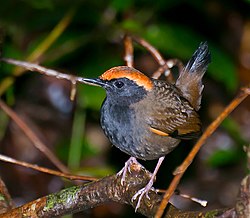Top Qs
Timeline
Chat
Perspective
Rufous-capped antthrush
Species of bird From Wikipedia, the free encyclopedia
Remove ads
The rufous-capped antthrush (Formicarius colma) is a small species of bird in the family Formicariidae located in the order Passeriformes. It is considered to be uncommon but widespread, found in Bolivia, Brazil, Colombia, Ecuador, French Guiana, Guyana, Peru, Suriname, and Venezuela. The rufous-capped antthrush is typically found inhabiting the shady floor of tall, humid forests on solid ground, and is occasionally spotted in transitional forests (várzea) and savanna forests (Suriname).[2]
Remove ads
Taxonomy and systematics
Summarize
Perspective
The rufous-capped antthrush was first described by the French polymath Georges-Louis Leclerc, Comte de Buffon in his 1779 journal Histoire Naturelle des Oiseaux (Natural History, General and Particular, with a Description of the King's Cabinet) from a specimen collected in Cayenne, French Guiana and was further engraved by François-Nicolas Martinet in the Planches Enluminées D'Histoire Naturelle (Illuminated Planks of Natural History) which was produced under the supervision of Edme-Louis Daubenton to accompany Buffon's text.[3][4] Neither Buffon's description nor Martinet's drawing included a scientific name, however, Dutch naturalist Pieter Boddaert coined the binomial name Formicarius colma (Formicarius being Latin for "of the ant") in his 1783 catalogue the Planches Enluminées, with the specific epithet colma forged by Buffon, most likely being a contraction of "collier" (necklace) and "marque" (mark).[5][6]
There are four recognized subspecies of Formicarius:[7]
- F. c. colma (Boddaert, 1783) – found in east Colombia, south Venezuela, the Guianas and north Brazil (north of the Amazon)
- F. c. nigrifrons (Gould, 1855) – found in east Ecuador, east Peru, north Bolivia and southwest Amazonian Brazil
- F. c. amazonicus (Hellmayr, 1902) – found in central Brazil
- F. c. ruficeps (von Spix, 1824) – found in east, southeast and south Brazil
The exact phylogeny of the rufous-capped antthrush is poorly understood, however, an estimated phylogeny was constructed in 1983 by Sibley and Ahlquist by comparing sixteen tracer-species through DNA–DNA hybridization.[8]
Remove ads
Description
Summarize
Perspective
The Formicarius colma is generally a small bird, averaging around 18 cm with males weighing between 38 and 49 grams and females between 41 and 49 grams. Males are marked by a black forehead, rufous-colored (red-brown) crown and nape, with the crown including a variable amount of black feathers. Its back, rump, and wings are olive-brown color with a dusky brown tail and black on the neck, throat, and sides of the head. The upper breast is a dark black that merges into a dark gray on the lower breast while the belly and flanks are a paler gray with (occasionally) a brown wash. Underwing coverts are marked by a mix of black and cinnamon with the inner webs of remiges being dusky with a broad cinnamon bar across the base. Facial features include a brown iris and black bill while the tarsus vary from light gray-brown to a purplish-gray. The female is largely the same as the male, being marked with a white throat rather than the black seen in males. The four subspecies differ slightly from each other; the nigrifrons largely resemble colma but with more black on the head, the amazonicus resemble the nigrifrons but smaller with a deeper rufous head, short tail, and browner upperparts, and the ruficeps having an extensively rufous head. Juvenile rufous-capped antthrushes are marked by a white throat (like the female) and black spotting. The song of the rufous-capped antthrush is generally a 4 to 6 second long, fast, even-paced trill of about 14 notes per second. This song is between 2.2 and 3kHz, with this frequency being speculated as optimal for communication in thick, humid underbrush. The call of the rufous-capped antthrush is described as a single, clear "psee-eh" or "pier," while the song is described as a "re-e-e-e-e-e-e-e-e-e-e-e-e-e-ee-ee-ee-ee-ee".[9][10]
Remove ads
Distribution and habitat
Summarize
Perspective
The F. colma is found in east Colombia (south of Vaupés), south and east Venezuela, the Guianas, and in Brazil north of the Amazon while the subspecies F. nigrifrons are found east of Ecuador, east of Peru, north of Bolivia (south to La Paz), and south of the Amazon. F. amazonicus is found in Brazil south of the Amazon, from east Madeira to north Maranhão, and south of Ji-Paranã and Mato Grosso. F. ruficeps is found on the coastal east and southeast of Brazil from Pernambuco to Rio Grande do Sul. The rufous-capped antthrush are widespread, predominately preferring the cooler, shady floor of terra firme forests, although they can occasionally be spotted inhabiting traditional forests and savanna forests. While they generally occupy the lowlands to 500m and locally to 1100m, interspecies aggression between the rufous-capped antthrush and F. analis has been observed to induce altitudinal displacement, with F. colma fleeing to higher and drier ravines and ridges while the F. analis occupy the lower lands. Additionally, in Manu, the black-faced antthrush, being both larger and more population-dense, dominate over the rufous-capped antthrush. While the two species frequently overlap due to F. colma's large distribution, the song of the F. colma has been reported to induce an aggressive response from the black-faced antthrush while the song of the black-faced antthrush causes recession of the rufous-capped antthrush, indicating further interspecies aggression. Other than interspecies aggression, the driving factor controlling the rufous-capped antthrush's distribution is poorly understood, as they are believed to be a sedentary species.[11][2]
Behavior and ecology
External links
Wikiwand - on
Seamless Wikipedia browsing. On steroids.
Remove ads



